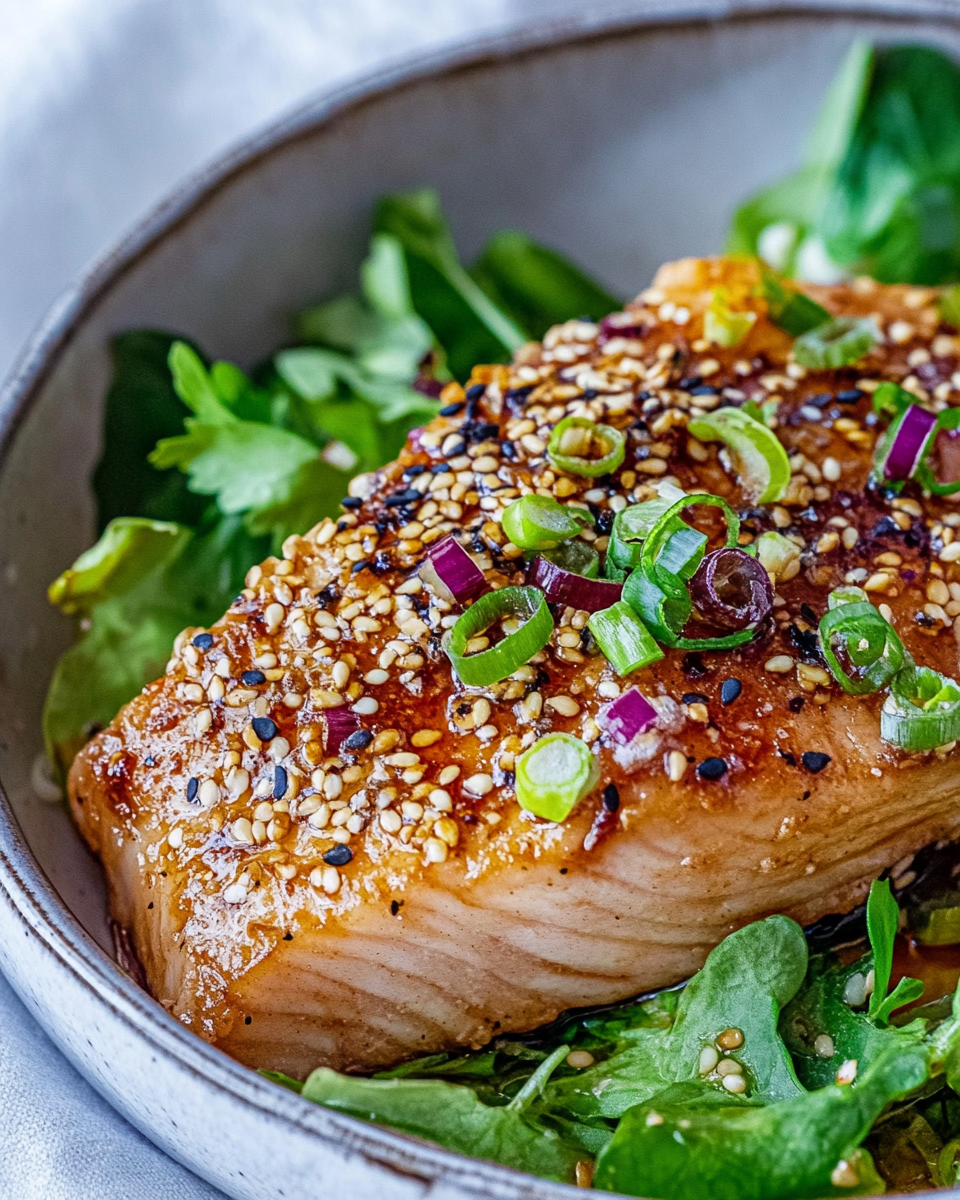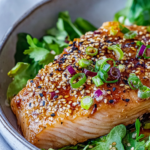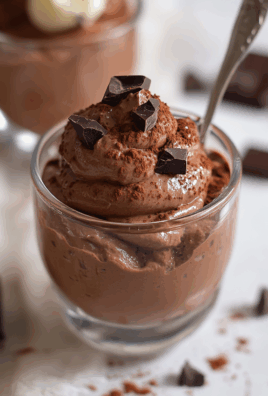Tuna steak is a fantastic choice for seafood lovers looking for a high-protein, nutrient-dense meal. This Asian Tuna Steak recipe features a rich, savory sesame-ginger marinade that enhances the natural umami flavors of the fish. The marinade seeps into the tuna, making each bite tender and packed with flavor. Whether you grill or sear it on a pan, this dish delivers a restaurant-quality experience with minimal effort.
This recipe is ideal for busy weeknights or special occasions. With just a few simple ingredients and quick preparation, you can have a gourmet meal in under 35 minutes. Plus, tuna is a great source of lean protein, healthy omega-3 fatty acids, and essential vitamins.

Why You’ll Love This Recipe
- Quick & Easy: Ready in about 30 minutes, including marination time.
- Healthy & Nutritious: High in protein and packed with omega-3s.
- Versatile Cooking Methods: Grill or pan-sear to perfection.
- Bold Asian Flavors: Soy sauce, sesame oil, and ginger add depth.
Essential Tools & Equipment
To prepare this dish, you’ll need a few key kitchen tools:
- Grill or Cast-Iron Skillet – Ensures a perfect sear.
- Mixing Bowl – For the marinade.
- Tongs – Makes flipping the tuna easier.
- Meat Thermometer – Ensures the ideal doneness.
Ingredients for Asian Tuna Steak
For the Tuna Steaks
- 2 fresh tuna steaks (sushi-grade recommended)
- 1 teaspoon sesame oil (adds nuttiness)
- 2 tablespoons olive oil (for richness)
- 1 tablespoon soy sauce (for umami depth)
- 1 teaspoon ground ginger (adds warmth)
- 1 teaspoon garlic powder (for extra depth)
- 1 tablespoon rice vinegar (adds a touch of acidity)
- 2 tablespoons sesame seeds, divided (for a crunchy crust)
- Green onions, sliced (for garnish)
Step-by-Step Cooking Instructions
Step 1: Prepare the Marinade
- In a mixing bowl, whisk together olive oil, sesame oil, soy sauce, ginger, garlic powder, rice vinegar, and half of the sesame seeds.
Step 2: Marinate the Tuna
- Place the tuna steaks in a shallow dish or resealable bag.
- Pour half of the marinade over the tuna, ensuring both sides are coated.
- Cover and refrigerate for at least 20 minutes (or up to overnight for stronger flavor).
Step 3: Preheat the Grill or Skillet
- Heat the grill to medium-high heat (350°F – 400°F).
- If using a cast-iron skillet, heat it over medium-high heat and lightly oil it.
Step 4: Coat the Tuna with Sesame Seeds
- Remove the tuna from the marinade, discarding the excess.
- Coat each steak with the remaining sesame seeds to create a crisp exterior.
Step 5: Cook the Tuna Steaks
- Place the tuna steaks on the grill or in the skillet.
- Sear for 2-3 minutes per side, depending on your preferred doneness.
- Drizzle some of the reserved marinade over the steaks while cooking.
- For medium-rare, remove at 135°F. For well-done, cook to 145°F.
Step 6: Garnish and Serve
- Remove from heat and let the tuna rest for 1-2 minutes.
- Sprinkle with sliced green onions and additional sesame seeds.
- Serve immediately with rice, vegetables, or a fresh salad.
This dish delivers a perfect balance of flavors, combining the natural richness of tuna with the bold taste of sesame, soy sauce, and ginger. By following these simple steps, you can achieve a beautifully seared tuna steak with a tender interior.
Perfect Side Dishes for Asian Tuna Steak
1. Steamed Jasmine Rice
The subtle, slightly sweet flavor of jasmine rice complements the umami depth of the tuna steak. Its soft texture helps balance the crisp sesame crust. You can also drizzle some of the reserved marinade over the rice for extra flavor.
2. Stir-Fried Vegetables
A mix of bok choy, bell peppers, snap peas, and carrots sautéed in sesame oil and garlic adds color and crunch. This side dish enhances the Asian-inspired flavors of the tuna while adding a healthy serving of fiber.
3. Garlic Butter Edamame
Lightly sautéed edamame tossed in garlic butter and a sprinkle of sea salt provides a simple yet delicious accompaniment. It pairs well with the tuna’s rich, meaty texture.
4. Asian Slaw
A crunchy slaw made with cabbage, carrots, and a sesame-ginger dressing offers a refreshing contrast to the warm, seared tuna. The crispness of the vegetables adds variety to the dish.
5. Miso Soup
A warm bowl of miso soup with tofu, seaweed, and scallions brings a classic Japanese touch to the meal. Its light, savory broth complements the tuna without overpowering it.
6. Cucumber Avocado Salad
Sliced cucumbers and avocados tossed in a light soy-sesame dressing create a cooling and creamy contrast to the bold flavors of the tuna. This is a great option if you’re looking for a low-carb pairing.
7. Sesame Noodles
Chilled or warm sesame noodles with a soy-ginger sauce make a flavorful and filling side dish. The nutty richness of sesame complements the flavors of the tuna while adding a satisfying texture.
8. Pickled Ginger & Wasabi
For a true Japanese-inspired experience, serve the tuna with thinly sliced pickled ginger and a small dab of wasabi. These condiments enhance the natural flavors of the fish while adding a subtle heat.
Common Mistakes to Avoid
Cooking tuna steak requires attention to detail. Here are some of the most common mistakes and how to avoid them.
1. Overcooking the Tuna
Tuna steak should be lightly seared on the outside while remaining pink or slightly rare inside. Cooking it for too long results in a dry, tough texture. For best results, aim for an internal temperature of 135°F for medium-rare and 145°F for well-done.
2. Using Low-Quality Tuna
The quality of the fish is crucial to the final taste and texture. Fresh, sushi-grade tuna is the best choice for grilling or pan-searing. If you use a lower-grade cut, it may have a strong fishy taste and a less desirable texture.
3. Not Letting the Tuna Rest
Just like beef steak, tuna needs a brief resting period after cooking. Letting it rest for 1-2 minutes helps retain its juices, keeping it moist and flavorful.
4. Skipping the Marination
While tuna is naturally flavorful, marinating enhances its taste and tenderness. Even a quick 20-minute marinade allows the flavors of soy, ginger, and sesame to penetrate the fish, making a noticeable difference in the final dish.
5. Cooking at the Wrong Temperature
If the heat is too low, the tuna will cook unevenly and won’t develop a proper sear. For best results, preheat your grill or skillet to medium-high (350°F – 400°F) before cooking. This ensures a golden crust while keeping the inside tender.
6. Using Too Much Oil on the Grill
A light coating of oil is enough to prevent sticking. Excess oil can cause flare-ups on the grill, which may lead to an uneven cook or a burnt exterior.
7. Not Experimenting with Flavors
While the sesame-ginger marinade is a great base, don’t be afraid to customize the seasoning. Adding a hint of chili flakes, Sriracha, or honey can create a unique twist on the classic recipe.
How to Serve Asian Tuna Steak
For the best presentation and taste, consider these final touches:
- Slice the Tuna Thinly: For an elegant plating, slice the tuna into thin strips rather than serving it whole. This allows each bite to showcase the seared exterior and tender pink center.
- Drizzle with Extra Marinade: Use the reserved marinade as a finishing sauce to enhance the flavor.
- Garnish for Visual Appeal: Sprinkle with additional sesame seeds, fresh green onions, or microgreens for a vibrant presentation.
Expert Tips for the Best Asian Tuna Steak
1. Choose Sushi-Grade Tuna for the Best Flavor
The quality of tuna affects both taste and texture. Sushi-grade tuna, such as ahi (yellowfin) or bluefin, is ideal for grilling because of its firm texture and mild flavor. Lower-quality tuna may have a stronger fishy taste and a less appealing texture.
2. Bring Tuna to Room Temperature Before Cooking
Cold tuna placed on a hot grill or pan can cook unevenly, with the outside overcooking before the inside reaches the desired doneness. Let the tuna rest at room temperature for about 10-15 minutes before cooking to ensure even searing.
3. Sear at High Heat for the Best Texture
A quick sear at medium-high heat (350°F – 400°F) creates a crisp sesame crust while keeping the inside tender and juicy. Cooking at lower temperatures may result in a dry, overcooked tuna steak.
4. Let the Tuna Rest Before Slicing
After removing the tuna from the grill, allow it to rest for 1-2 minutes. This helps retain its natural juices, keeping it moist and flavorful when sliced.
5. Customize the Marinade to Suit Your Taste
While the sesame-ginger marinade provides a great base, you can easily adjust it to match your preferences:
- For a spicier version, add red pepper flakes, Sriracha, or a dash of wasabi.
- For a hint of sweetness, mix in honey or brown sugar.
- For a citrus twist, add fresh lime or orange zest.
6. Experiment with Different Cooking Methods
While grilling is a great way to cook tuna steak, you can also try:
- Pan-Searing: Use a hot cast-iron skillet for a deep, golden crust.
- Oven-Baking: Bake at 400°F for 8-10 minutes for a more evenly cooked result.
- Air-Frying: Cook at 390°F for 6-8 minutes, flipping halfway through.
Storage & Reheating Instructions
If you have leftovers, proper storage and reheating methods will help maintain the flavor and texture of the tuna steak.
How to Store Cooked Tuna Steak
- Refrigerate: Place leftover tuna steak in an airtight container and store in the refrigerator for up to 2 days.
- Freeze: If you need to store it longer, wrap the tuna tightly in plastic wrap and place it in a freezer-safe bag. It will keep for up to 2 months in the freezer.
Best Ways to Reheat Tuna Steak
Tuna steak is best enjoyed fresh, but if you need to reheat it, use gentle methods to prevent overcooking.
- Oven: Preheat the oven to 275°F. Place the tuna on a baking sheet and cover with foil. Warm for 5-7 minutes until heated through.
- Skillet: Heat a small amount of oil in a pan over low heat. Sear each side for about 1 minute to warm the tuna without drying it out.
- Avoid Microwaving: Microwaving can make tuna steak rubbery and overcooked. If necessary, use the lowest power setting and heat in 10-second intervals.
Frequently Asked Questions (FAQs)
1. Can I Use Frozen Tuna Steaks for This Recipe?
Yes, but make sure to thaw them properly before cooking. Place frozen tuna steaks in the refrigerator overnight or use the cold water method for a quicker thaw. Pat them dry before marinating to ensure even absorption of flavors.
2. Can I Cook Tuna Steak Well-Done?
While tuna is best enjoyed medium-rare (135°F) for a tender, juicy texture, you can cook it to 145°F for well-done. Keep in mind that fully cooked tuna may be drier, so adding extra marinade or sauce can help maintain moisture.
3. What’s the Best Oil to Use for Cooking Tuna Steak?
Sesame oil adds a nutty depth, but if you need an alternative, avocado oil, coconut oil, or grapeseed oil work well. These oils have high smoke points and won’t overpower the natural flavor of the tuna.
4. How Can I Make This Dish Gluten-Free?
To make this recipe gluten-free, use tamari or coconut aminos instead of soy sauce. These alternatives provide the same rich umami flavor without gluten.
5. Can I Marinate the Tuna for Longer?
Yes, you can marinate the tuna for up to 24 hours in the refrigerator. However, since the marinade contains vinegar, marinating for too long may slightly alter the texture of the fish. If marinating overnight, reduce the vinegar amount to prevent the tuna from becoming too soft.
6. What Can I Do with Leftover Tuna Steak?
If you have leftover tuna, repurpose it into a new dish:
- Tuna Salad: Flake the tuna and mix it with avocado, cucumbers, and sesame dressing.
- Tuna Poke Bowl: Slice the tuna thinly and serve over rice with edamame, mango, and a drizzle of soy sauce.
- Tuna Wraps: Roll slices of tuna in a lettuce wrap with shredded carrots and spicy mayo.
- Tuna Tacos: Use warm corn tortillas, shredded cabbage, and a squeeze of lime for a fresh take on fish tacos.
Final Thoughts
Asian Tuna Steak is a simple yet elegant dish that delivers bold flavors with minimal effort. By following the right cooking techniques, choosing quality ingredients, and pairing the tuna with complementary sides, you can create a well-balanced meal that feels restaurant-worthy.
Whether you enjoy it fresh off the grill or use leftovers creatively, this dish is versatile enough to fit different tastes and dietary preferences. Try it with a side of jasmine rice, miso soup, or a fresh salad for a complete meal.
Would you like to explore additional variations, such as a miso-glazed or teriyaki version?
Asian Tuna Steak
Ingredients
- 2 tuna steaks
- 2 tablespoons olive oil
- 1 teaspoon sesame oil
- 1 teaspoon ground ginger
- 1 tablespoon soy sauce
- 1 teaspoon garlic powder
- 1 tablespoon rice vinegar
- 2 tablespoons sesame seeds divided
- Green onion sliced (for garnish)
Instructions
- Preheat the grill to medium-high heat (350°F).
- In a small bowl, whisk together the olive oil, sesame oil, ginger, soy sauce, garlic powder, rice vinegar, and half of the sesame seeds.
- Pour half of the marinade over the tuna steaks, reserving the other half for later. Cover and refrigerate for at least 20 minutes (or up to overnight) while the grill heats.
- Once the grill is hot, remove the tuna steaks from the marinade and discard the excess marinade.
- Coat the tuna steaks with 1 tablespoon of sesame seeds (or more if needed) to create a crust.
- Place the tuna steaks on the grill and cook for 2-3 minutes per side, drizzling a bit of the reserved sauce on top while grilling.
- For medium-rare tuna, cook until the internal temperature reaches 135°F. For well-done tuna, cook to 145°F.
- Remove from the grill and top with the remaining sauce, green onions, and additional sesame seeds.
- Serve immediately and enjoy!




Leave a Comment